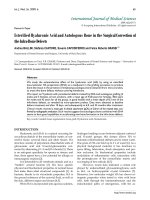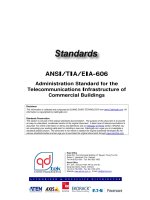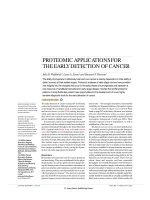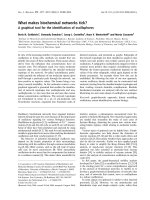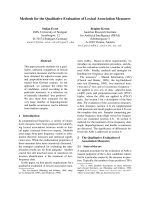Anterior vertebral stapling for the fusionless correction of scoliosis
Bạn đang xem bản rút gọn của tài liệu. Xem và tải ngay bản đầy đủ của tài liệu tại đây (1.01 MB, 79 trang )
Anterior Vertebral Stapling for the
Fusionless Correction of Scoliosis
An anatomical and biomechanical investigation
Master of Engineering Thesis
School of Engineering Systems, QUT
Submitted by
Dr MARK PERNELL SHILLINGTON B.Phty., M.B.B.S.
November 2008
1
KEYWORDS
Fusionless scoliosis surgery, spine biomechanics, thoracic spine, staples, shape
memory alloy, strain, growth modulation, hemiepiphysiodesis, bovine vertebra,
micro-computed tomography, endoscopy, thorascopic.
2
ABSTRACT
Fusionless scoliosis surgery is an emerging treatment for idiopathic scoliosis as it
offers theoretical advantages over current forms of treatment. Currently the
treatment options for idiopathic scoliosis are observation, bracing and fusion. While
brace treatment is non-invasive, and preserves the growth, motion, and function of
the spine, it does not correct deformity and is only modestly successful in
preventing curve progression. In adolescents who fail brace treatment, surgical
treatment with an instrumented spinal fusion usually results in better deformity
correction but is associated with substantially greater risk. Furthermore in younger
patients requiring surgical treatment, fusion procedures are known to adversely
effect the future growth of the chest and spine. Fusionless treatments have been
developed to allow effective surgical treatment of patients with idiopathic scoliosis
who are too young for fusion procedures. Anterior vertebral stapling is one such
fusionless treatment which aims to modulate the growth of vertebra to allow
correction of scoliosis whilst maintaining normal spinal motion
The Mater Misericordiae Hospital in Brisbane has begun to use anterior vertebral
stapling to treat patients with idiopathic scoliosis who are too young for fusion
procedures. Currently the only staple approved for clinical use is manufactured by
Medtronic Sofamor Danek (Memphis, TN). This thesis explains the biomechanical
and anatomical changes that occur following anterior vertebral staple insertion
using in vitro experiments performed on an immature bovine model. Currently
there is a paucity of published information about anterior vertebral stapling so it is
hoped that this project will provide information that will aid in our understanding of
the clinical effects of staple insertion.
The aims of this experimental study were threefold. The first phase was designed to
determine the changes in the bending stiffness of the spine following staple
insertion. The second phase was designed to measure the forces experienced by
the staple during spinal movements. The third and final phase of testing was
designed to describe the structural changes that occur to a vertebra as a
consequence of staple insertion.
3
The first phase of testing utilised a displacement controlled testing robot to
compare the change in stiffness of a single spinal motion segment following staple
insertion for the three basic spinal motions of flexion-extension, lateral bending,
and axial rotation. For the second phase of testing strain gauges were attached to
staples and used to measure staple forces during spinal movement. In the third and
final phase the staples were removed and a testing specimen underwent microcomputed tomography (CT) scanning to describe the anatomical changes that occur
following staple insertion.
The displacement controlled testing showed that there was a significant decrease in
bending stiffness in flexion, extension, lateral bending away from the staple, and
axial rotation away from the staple following staple insertion. The strain gauge
measurements showed that the greatest staple forces occurred in flexion and the
least in extension. In addition, a reduction in the baseline staple compressive force
was seen with successive loading cycles. Micro-CT scanning demonstrated that
significant damage to the vertebral body and endplate occurred as a consequence
of staple insertion.
The clinical implications of this study are significant. Based on the findings of this
project it is likely that the clinical effect of the anterior vertebral staple evaluated in
this project is a consequence of growth plate damage (also called
hemiepiphysiodesis) causing a partial growth arrest of the vertebra rather than
simply compression of the growth plate. The surgical creation of a unilateral growth
arrest is a well established treatment used in the management of congenital
scoliosis but has not previously been considered for use in idiopathic scoliosis.
4
TABLE OF CONTENTS
Chapter
Page
List of key words
2
Abstract
3
Table of illustrations and diagrams
7
Statement of original authorship
11
Acknowledgements
12
1. Clinical Problem and Study Aims
13
2. Literature Review
21
2.1 Vertebral anatomy and growth modulation
21
2.2 Anterior vertebral stapling
26
2.2.1 Animal studies of anterior vertebral stapling
26
2.2.2 Clinical results of anterior vertebral stapling
30
2.2.3 Aspects of staple design
31
2.2.4 Thorascopic approaches to spinal surgery
34
2.3 Biomechanical testing of anterior vertebral stapling
35
2.3.1 Results of biomechanical testing
35
2.3.2 The use of calf spine models
36
2.3.3 Load vs. displacement controlled testing
38
5
3. Materials and Methods
3.1 Displacement controlled testing
41
42
3.2 Measurement of staple loading during spinal movement 47
3.3 Vertebral structural change following staple insertion
4. Results
50
51
4.1 Displacement controlled testing
51
4.2 Measurement of staple loading
57
4.3 Changes in vertebral structure following staple insertion 59
5. Discussion and Conclusions
61
References
67
Appendix 1: The effect of temperature on staple stiffness
74
Appendix 2: Post-test x-rays confirming staple position
77
6
TABLE OF ILLUSTRATIONS AND DIAGRAMS
Figures
Page
1. Scoliosis deformity
13
2. (a) Coronal plane radiograph demonstrating a scoliosis, and
14
(b) Schematic drawing illustrating the measurement of a Cobb angle.
14
3. Cervicothoracolumbosacral orthosis (CTLSO).
15
4. Radiographs demonstrating a thoracic fusion procedure.
16
5. (a) The shape memory alloy (SMA) staple, and
18
(b) Demonstration of staple insertion via thorascopic technique.
6. (a) Intra-operative photos of staple insertion, and
(b) Post-operative radiographs.
18
19
19
7. Schematic diagram showing the anatomy of a growing vertebra
in the coronal plane.
22
8. Schematic demonstration of physeal stapling to correct angular
B
9. T
23
24
10. Radiograph demonstrating the creation of an experimental scoliosis
in a goat using an asymmetrical rigid spinal tether.
25
11. Post-operative radiograph from Nachlas and Borden showing a staple
inserted into a dog spine.
26
12. Radiographs demonstrating the creation of an experimental scoliosis
in a goat.
13. (a) and (b), two alternative proposed staple designs.
27
29
7
14. Schematic drawing showing the tool used for intra-operative
templating to determine staple size.
15. Intra-operative photograph demonstrating the thorascopic approach.
33
34
16. Schematic diagram representing (a) load-controlled compared to
(b) displacement-controlled testing.
39
17. A functional spinal unit following preparation for testing.
42
18. The testing robot.
43
19. (a) The testing specimen fixed to the base plate, and
44
(b) coupled to the testing apparatus.
44
20. Schematic diagram illustrating staple position in the spine.
46
21. Insertion of the SMA staple during testing.
46
22. Post- test radiograph confirming staple position.
46
23. (a) SMA staple with a strain gauge attached, and
48
(b) set-up prior to testing, and
48
(c) strain gauge connected to data logger.
48
24. Definition of equivalent staple tip force.
49
25. Staple tip force calibration for two of the strain gauged staples
used in the testing.
50
26. Representative load-displacement graph for flexion-extension in the
(a) control, and (b) stapled conditions.
54
27. Representative load-displacement graph for lateral bending in
(a) control, and (b) staple conditions
55
28. Representative load-displacement graph for axial rotation in
(a) control, and (b) staple conditions.
29. Time based plot of staple tip forces in flexion extension.
56
57
8
30. Time based plot of staple tip force in lateral bending.
58
31. Time base plot of staple tip loading in axial rotation.
58
32. Coronal plane reconstruction of micro-CT.
60
33. Axial reconstruction of the micro-CT.
60
34. Photograph of an SMA staple.
66
9
Tables
1. Ranges of motion used for testing and order of tests.
Page
45
2. Results of paired t-tests comparing the stiffness of non-stapled and
stapled motion segments.
52
3. Mean, minimum, maximum, and median stiffness values for each
direction of movement in the control and stapled conditions (Nm/°).
53
10
Statement of Original Authorship
The work contained in this thesis has not been previously submitted to meet
requirements for an award at this or any other higher education institution. To the
best of my knowledge and belief, the thesis contains no material previously
published or written by another person except where due reference is made.
Mark P Shillington, 12th November, 2008.
11
ACKNOWLEDGEMENTS
To Clayton Adam, without whom this project would not have been possible. Your
patience , approachable nature, and guidance inspired me to achieve new goals
that would not have been possible without your help. Thanks for being contactable
and always available and willing to help. Working with you has taught me many
new skills and inspired an enthusiasm for research that I know will make me a
better doctor.
To Geoffrey Askin and Robert Labrom, thank you for providing me with the
wonderful opportunities that this job has given me. Having two experienced
paediatric spinal surgeons who are friendly and encouraging as my mentors has
been invaluable for my development.
Maree Izatt, thanks for always being welcoming and obliging, and for always
providing me assistance with a smile. Your ability to provide information, pictures,
articles, and technical advice, often at very short notice, was much appreciated.
Helen Cunningham, thanks for your help with learning the
s of George
and with the staple strain gauge testing. I really appreciated your generosity with
your time when you had more than enough things on your plate!
Rob McPhee and National Surgical, thank-you for providing the staples for testing
and the equipment required for their use.
Kristen Gilshenan, thank-you so much for your help with the statistics.
Brendon Evans, thanks for your assistance with the staple stiffness tests.
Last, but not least, thanks to my wife Rhiannon whose loving support allows me to
be the best person I can be every day.
12
CHAPTER 1. CLINICAL PROBLEM AND STUDY AIMS
This chapter describes the clinical problems associated with current treatment
methods for scoliosis, and details the aims and objectives of this study.
Scoliosis, simply defined as lateral curvature of the spine, has been recognised
clinically for centuries. The first descriptions of this condition were seen in ancient
Hindu religious literature (circa 3500-1800 BC) where the treatment of spinal
deformity was clearly described.
58
Over time our understanding of this condition
has increased significantly yet many aspects of the condition still remain not fully
understood. It is now recognised that the original descriptions of scoliosis as purely
a lateral curvature of the spine were oversimplified, and rather the condition
involves a complex three-dimensional deformity of the spine (Figure 1).
99
For
practical purposes, however, the curvature is conventionally described and
measured in one plane using standing coronal plane radiographs and the Cobb
technique (Figure 2). 28
This figure is not available online.
Please consult the hardcopy thesis
available from the QUT Library
Figure 1. Scoliosis deformity
99
13
This figure is not available online.
Please consult the hardcopy thesis
available from the QUT Library
(a)
(b)
Figure 2. (a) Coronal plane radiograph demonstrating a scoliosis, and (b)
98
schematic drawing illustrating the measurement of a Cobb angle.
Paediatric spinal deformities such as scoliosis may result from many causes
including neuromuscular disorders, congenital abnormalities, neurofibromatosis,
connective tissue disorders, and skeletal dysplasia, however, in the majority of
cases the cause is unknown, with this group referred to as idiopathic scoliosis. The
aetiology of idiopathic scoliosis is incompletely understood but both genetic 70 and
environmental
44
factors are thought to be involved. The prevalence rate of
idiopathic scoliosis is approximately two percent with females having a far higher
incidence than males. 55,111
Based on the observation of three distinct peak periods of onset, patients with
idiopathic scoliosis have been sub-divided into three groups based on the age at
which they are diagnosed; (1) infantile, onset before age three years; (2) juvenile,
age three to ten years; and (3) adolescent, age ten years until the end of growth. 54
Eighty percent or more of idiopathic scoliosis is of the adolescent variety. 85
14
When making decisions about the treatment of patients with idiopathic scoliosis
one of the primary considerations is the likelihood of the curve progressing in size.
The natural history of curve progression
maturity, the curve pattern, and the curve severity.
6,14,23,61
Thus patients with
significant growth potential and/or large curves at presentation are more likely to
progress without treatment.
Until recently, the options for treatment of progressive scoliosis in a growing child
were limited to observation, bracing, and surgery.
61,111
In patients with curves
measuring 20 to 40 degrees the current standard of care is bracing with a
cervicothoracolumbosacral orthosis (CTLSO) (see Figure 3) or a thoracolumbosacral
orthosis (TLSO). Current reports show only modest results for this treatment, with
18 to 50 percent of treated curves progressing despite bracing.
2,56,61,71,82,90,111
In
addition brace wear can be associated with many other problems including
concerns about the effects of sustained pressure on the growing chest wall and the
psychological impact related to the stigmata of having to wear a brace, especially in
children who have to wear the brace for many years.
3,7,26,27,37,56,60,64,75
Also, while
brace treatment is non-invasive and preserves the growth, motion, and function of
the spine, it does not correct an established deformity of the spine. While most
orthopaedic surgeons, families, and patients agree that it is reasonable to wear a
scoliosis brace for one or two years if it means preventing an operation, a more
difficult situation is encountered in the very young child who faces the prospect of
wearing a brace for many years with no guarantee of a favourable outcome.
Figure 3. Cervicothoracolumbosacral orthosis (CTLSO)
15
For growing children that fail brace treatment or have more severe scoliosis,
surgery is often considered. Operative treatment consists of spinal instrumentation
with or without vertebral fusion. It may be carried out via a posterior, anterior (as
shown in Figure 4) or combined approach. Although an instrumented spinal fusion
provides better deformity correction than brace treatment, it is more invasive and
carries more risk. Spinal instrumentation procedures, whether anterior or posterior,
require extensive surgical dissection to expose the spine and prepare for fusion.
The instantaneous correction of spinal deformity achieved during an instrumented
spinal fusion procedure also carries the risk of neurologic injury. In addition, even
with safe correction of scoliosis and a solid fusion, the growth, motion, and function
of the fused portion of the spine are eliminated, perhaps increasing the risk of
adjacent segment degeneration and spinal imbalance problems in the future.
Figure 4. Radiographs demonstrating an anterior
thoracic fusion procedure
16
To address this clinical problem, new fusionless treatment options are being
developed. There are many synonyms for fusionless scoliosis surgery, including
anterior or endoscopic vertebral stapling, convex scoliosis tethering, mechanical
modulation of spinal growth, guided spinal growth, and even internal bracing of
spinal deformity. Regardless of the name or implant applied to this unique method
of treatment, the goal remains the same: to harness the inherent spinal growth of
the patient with scoliosis and redirect it to achieve correction of the deformity. Like
bracing, the fusionless treatment of scoliosis aims to preserve the growth, motion,
and function of the spine but is also potentially more mechanically advantageous as
corrective forces are applied directly at the spine rather than via the chest wall and
ribs. Furthermore, unlike with bracing, the effectiveness of these treatments is not
dependent on patient compliance. Like other surgical options, fusionless
treatments are invasive, but less so with no requirement for extensive dissection of
tissue. In addition, the neurological risk associated with instantaneous correction of
deformity using rigid instrumentation may be lessened in fusionless surgery.
Furthermore, the preservation of spinal motion and function may protect adjacent
segments from premature degeneration over time.
Anterior vertebral stapling is becoming an increasingly popular fusionless treatment
technique for young patients with idiopathic scoliosis who require surgical
treatment. Currently the only staple with Therapeutic Goods Administration (TGA)
and Food and Drug Administration (FDA) approval specifically for use in the anterior
spine
“
M
A
“
“MA
1
which is manufactured by
Medtronic. This staple is inserted via a thorascopic approach into the convex side of
a scoliosis curve and spans adjacent vertebral endplates and discs (see Figures 5
and 6). It is believed that the staples act as a mechanical tether across adjacent
vertebral growth plates on the convexity of the curve thus slowing growth and
allowing deformity correction as the spine grows.
1
See Section 2.2.3 on page 31 for further explanation of shape memory alloys and their use in staple
design.
17
This figure is not available online.
Please consult the hardcopy thesis
available from the QUT Library
Figure 5. (a) The Medtronic SMA staple and (b) demonstration of
67
insertion via thorascopic technique
18
(a)
(b)
Figure 6. (a) Intra-operative photos of staple insertion and
(b) post-operative radiographs
19
Despite the increasing clinical and academic interest in SMA staples, little is known
about the anatomical effects of staple insertion on the vertebrae or the
biomechanical consequences of their insertion on the spine. Accordingly, this study
aims to investigate the consequences of SMA stapling in the thoracic spine to
advance the understanding of this new treatment. Specifically, the objectives of the
study are;
1. To experimentally determine the changes in bending stiffness of the
thoracic spine in flexion, extension, lateral bending, and axial rotation
following insertion of an SMA staple using a bovine model.
2. To measure and describe the forces which are placed on staples during
spinal movements.
3. To describe the anatomical changes in vertebral structure associated with
staple insertion.
20
CHAPTER 2. LITERATURE REVIEW
This chapter describes literature relevant to the use of anterior vertebral staples to
correct adolescent idiopathic scoliosis.
2.1 Vertebral anatomy and growth modulation
Beginning in childhood, vertebrae grow through thin growth plates on the superior
and inferior vertebral end-plates and from the neuro-central, articular process and
spinous process synchondroses (see Figure 7).
11,12,111
There is broad agreement
that the anatomical abnormalities seen in the vertebrae of patients with scoliosis,
which include vertebral wedging, disproportionate anterior spinal overgrowth, and
intra-vertebral rotation, suggest that asymmetrical vertebral growth has occurred.
13,34,45,46,79,80,88,97
All types of scoliosis progress faster following the pubescent
growth spurt, indicating that the shape of the vertebral body changes most rapidly
with vertebral growth.
62,112
Therefore, because scoliosis progresses during the
pubescent growth spurt, it is likely that the vertebral body growth plate is a major
factor in the development of the scoliosis deformity. It was from this background
information that the SMA staple was developed. Anterior vertebral stapling is
proposed to have its effect by controlling the growth of the vertebral growth plate
and thus correcting, or at least minimising, progression of the deformity.
21
Figure 7. Schematic diagram showing the anatomy of a growing vertebra in the
coronal plane. The block arrow indicates the location of the growth plate between the
vertebral body and the hyaline cartilage end plate
The concept of growth modulation through mechanical tethering of the growth
plate is well accepted for treating angular deformity of long bones in children (genu
varum, genu valgum). This technique was pioneered by W.P. Blount in the late
1940's when stapling of the tibial physis for the correction of angular deformity was
introduced.
15
I B
, the medial aspect of the proximal
tibial physis grows slowly. Therefore, treatment is directed at restricting lateral
tibial physeal growth. Staples across the physis limit growth asymmetrically,
allowing deformity correction with continued growth of the unrestricted medial
side of the growth plate (Figure 8). This experience with long bones provides a
background rationale for attempting growth modulation in the deformed vertebral
bodies of the scoliotic spine.
22
This figure is not available online.
Please consult the hardcopy thesis
available from the QUT Library
Figure 8. Schematic demonstration of physeal stapling to correct angular deformity of the tibia
106
B
Although the aetiology of idiopathic scoliosis is poorly understood, it is thought that
mechanical factors play an important role in the progression of the deformity
during growth.
4,16,32,41,66,81,86,95,118
More specifically, the progression of vertebral
wedge deformities is thought to be governed by the Hueter-Volkmann law.
5,52,68,69,100,101,108
Under this law, growth plates subjected to increased compressive
forces will demonstrate reduced growth, while those subjected to increased
distractive forces will demonstrate accelerated growth. The
vicious cycle
established by this growth differential is thought to contribute to the progression of
scoliosis deformity (Figure 9). 102
23
This figure is not available online.
Please consult the hardcopy thesis
available from the QUT Library
Figure 9. T
curvature increases during growth because it leads to
asymmetric loading of vertebrae, which in turn causes
100
asymmetric growth and additional wedging of the vertebrae.
Using a rat-tail model Stokes et al demonstrated that mechanical modulation of
vertebral growth could be predicted by the Hueter-Volkmann law.
101
With the
application of an external fixator to rat-tail vertebral segments, symmetric
compressive axial loads reduced growth to 68% of controls, whereas symmetric
tensile axial loads augmented growth to 114% of controls. Subsequent studies of
asymmetric loads applied to vertebral segments in a rat-tail not only resulted in
differential growth but also allowed for the creation and correction of vertebral
wedge deformities. 68,69
Although Stokes et al
101
laid the groundwork for additional studies of mechanical
modulation of growth in the vertebrae, the rat-tail model did not provide adequate
approximation of the anatomy and function of the human spine. The rat-tail model
is ideal for an isolated study of growth modulation in a single vertebra, however,
the methods and fixators used in this model are not directly applicable to scoliosis.
To better understand the mechanics of growth modulation in scoliosis, larger
animal models, approximating the size of a juvenile human, have been undertaken.
24
Growth modulation via the Hueter-Volkmann effect has been demonstrated in a
number of large animal studies in calf
73,74
, pig
25,110,113
, and goat
18-20,22,92
models.
Each of these studies used either an asymmetrical rigid spinal tether (see Figure 10),
rib resection, or a vertebral stapling or plating procedure to create asymmetrical
loading on the vertebral growth plate and achieve growth modulation of vertebral
growth.
This figure is not available online.
Please consult the hardcopy thesis
available from the QUT Library
Figure 10. Radiograph demonstrating the creation of an experimental
17
scoliosis in a goat using an asymmetrical rigid spinal tether.
25

